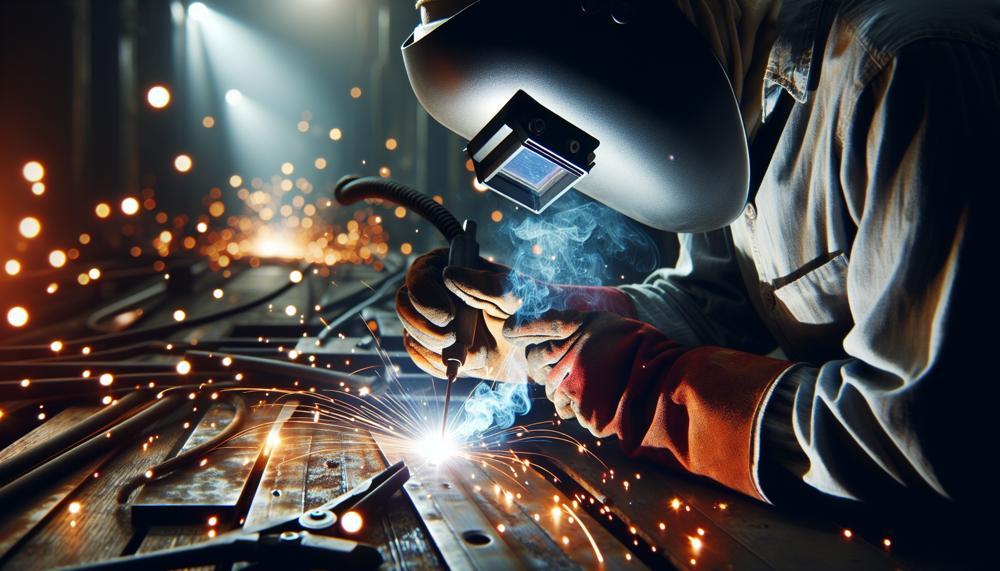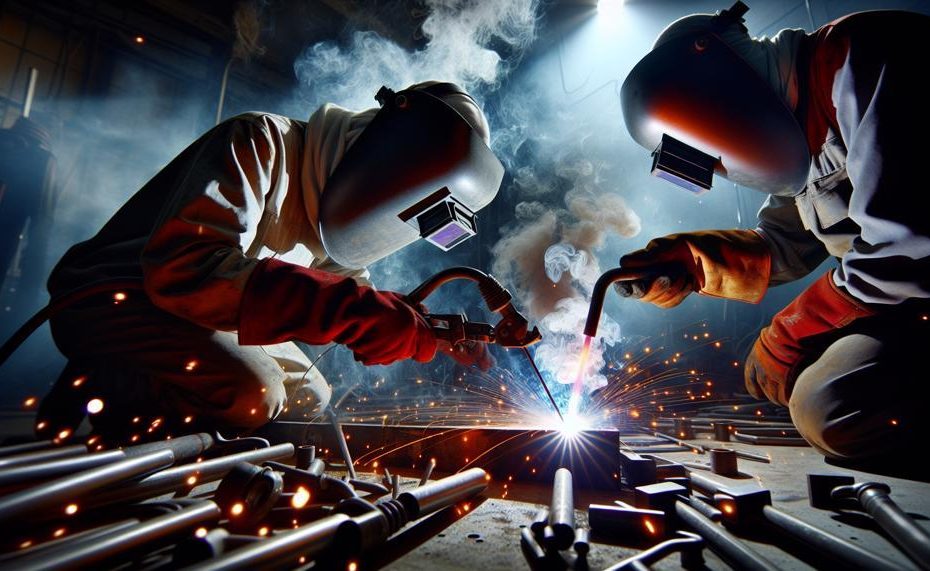This tried-and-true technique has been utilized for decades in various industries such as automotive, construction, and aerospace. But what exactly is arc spot welding? Let’s delve into the details:
- Arc spot welding is a type of electric resistance welding that creates a strong bond between two pieces of metal by utilizing heat generated from an electrical current.
- The process involves clamping two metal pieces together and applying pressure while an electric current passes through them.
- The intense heat created by the current melts the metal at the contact points, causing them to fuse together.
- Unlike traditional welding methods that require continuous feeding of filler material, arc spot welding does not use any filler material.
- This makes it a cost-effective and efficient method for joining thin sheets of metal.
Now that you have a basic understanding of arc spot welding, let’s dive into its benefits, applications, and how it compares to other types of welding.
So, let’s start.
Contents
- 1 How Are Arc Spot Welds Made?
- 2 What are Weld Washers?
- 3 Should Weld Washers Be Used for All Deck Welding?
- 4 What is the Most Common Filler Metal?
- 5 What Welding Parameters Should be Used?
- 6 Are Welding Procedure Specification (WPS) Documents Required?
- 7 What Inspection is Required for Deck Welding?
- 8 What are the Key Take-Away Points?
- 9 Conclusion
How Are Arc Spot Welds Made?
Arc spot welding is a specialized welding process that utilizes a welding machine, copper electrodes, and an electric arc to fuse two metal pieces together. The process begins by creating an electric arc between the electrode and the workpiece, which melts the metal and creates a bead by moving the arc along the joint. Properly shaping the bead is crucial for achieving a clean and smooth weld.
To ensure strong welds, excess material must be removed between passes, and weld washers may be utilized to control heat levels. The selection of the right filler metal, such as mild steel, is also essential for high-quality welds.
It is equally important to set the correct parameters, including welding current and travel speed.
The use of Welding Procedure Specification (WPS) documents is vital in ensuring quality welds by providing specific guidelines for procedures and materials used in welding operations. This guarantees that industry standards are adhered to in the process.
Arc spot welding is commonly used on steel decks, making it necessary to have proper equipment, materials, and follow safety measures to achieve desired results.
What are Weld Washers?
Weld washers, also known as metal discs, are utilized in the process of arc spot welding to establish a reliable and consistent electrical connection between the welding electrodes and the workpieces.
These discs act as a heat sink, preventing any warping or burning of thinner metals, while also ensuring a clean surface for improved visibility and adjustments during welding.
It is crucial to use weld washers when working with metals that are 20 gauge thickness or less.
To effectively incorporate weld washers in the arc spot welding process, follow these simple steps:
- Prepare the materials: Gather all necessary materials such as the welding machine, copper electrodes, filler metal, and weld washers.
- Clean the surfaces: Ensure that all surfaces are free from any rust, oil, or other contaminants that may impact the quality of the weld.
- Set up the welding machine: Adjust the power settings on the welding machine according to the thickness of the metal being welded. Detailed instructions can be found in WPS documents.
- Position the weld washers: Place the weld washers between the electrodes and the workpieces, ensuring direct contact with both.
- Strike an arc: Once ready, create an arc by briefly touching the electrode to the base metal and immediately pulling it away. This generates heat that will melt the filler metal and fuse it with the base metal.
- Continue welding: Move along the joint while maintaining a consistent arc length and speed to ensure even penetration. If needed, make adjustments to power settings or reposition weld washers for better heat control.
- Finish the weld: When reaching the end of the joint, release pressure on the electrode to break the arc and allow it to cool down naturally.
- Clean up: Use a chipping hammer or wire brush to remove any spatter or slag from the finished weld.
Should Weld Washers Be Used for All Deck Welding?
The question of whether or not to use weld washers for deck welding comes with both advantages and potential downsides. On one hand, they can provide a more robust weld by acting as a heat sink and preventing warping. This is especially useful when working with delicate materials as it can prevent any potential burn-through.
Moreover, utilizing weld washers ensures a neat surface for improved visibility while welding, resulting in accurate and precise work.
Nevertheless, there are also potential downsides to using weld washers for deck welding. One major disadvantage is that it may increase the cost and complexity of the project. Weld washers are an additional material that needs to be purchased and incorporated into the welding process, which can add to the overall expense. They may also add complexity to the project as they require precise positioning on the surface being welded.
It is essential to consider these benefits and potential downsides when deciding whether or not to use weld washers for deck welding. In some situations, they may be necessary for achieving a sturdy and long-lasting weld, but in others, alternative methods may be just as effective without adding extra costs or complexity to the project.
| Benefits | Potential Downsides |
| Can provide a sturdier weld by acting as a heat sink and preventing warping. | May increase the cost and complexity of the project. |
| Ensures a tidy surface for better visibility while welding. | |
| Can prevent burn-through on delicate materials. |
What is the Most Common Filler Metal?
Arc spot welding requires the use of filler metals to create a molten pool between two metal surfaces, which then solidifies to form a strong welded connection.
Different welding techniques require different types of filler metals, each with their own unique characteristics and uses.
Mild Steel Filler Metal
Mild steel is the most widely used filler metal in arc spot welding due to its affordability, versatility, and compatibility with various welding methods. This low-carbon steel alloy is easy to weld and offers good strength and ductility.
Mild steel filler metal is suitable for welding a wide range of materials, including carbon steels, low alloy steels, and even cast iron.
Flux-Cored Wires
Flux-cored wires are another type of filler metal commonly used in arc spot welding. These wires have a hollow core filled with flux, which produces a protective gas when heated that shields the weld from contaminants in the atmosphere.
Flux-cored wires are ideal for shielded metal arc welding (SMAW) and gas metal arc welding (GMAW).
Tungsten Inert Gas (TIG) Electrodes
Tungsten inert gas (TIG) electrodes are frequently used in arc spot welding to weld aluminum and other non-ferrous metals.
These electrodes are made from pure tungsten or a tungsten alloy and require a separate shielding gas, such as argon or helium, to protect the weld from atmospheric contamination.
What Welding Parameters Should be Used?
When it comes to determining the best welding parameters for arc spot welding, there are many important factors to take into account.
These include heat input, welding current, welding speed, electrode extension, shielding gas, and other related factors such as welding technique and the thickness of the base metal.
Heat input is a crucial factor in arc spot welding as it directly impacts the size, penetration, and overall integrity of the weld. Too much heat can lead to burn-through or distortion, while too little heat can result in weak welds with lack of fusion.
Another key factor is welding current, which determines the amount of heat generated and has a direct effect on the quality and mechanical properties of the weld.
Welding speed is also a critical consideration as it affects the cooling rate and can impact the microstructure and mechanical properties of the weld. A slower welding speed allows for more heat to be absorbed, resulting in a larger weld with deeper penetration. Conversely, a faster welding speed produces a smaller, shallower weld with less heat input.
Electrode extension is another important parameter that controls the length of the arc and heat transfer during welding. If the extension is too short, there may not be enough heat input, whereas too long of an extension can lead to excessive heat input and potential defects.
Additionally, shielding gas is often used in certain processes to protect against atmospheric contamination and ensure proper weld integrity.

Other factors that should be taken into consideration when determining welding parameters include voltage, current, travel speed, electrode size, joint configuration, and desired weld characteristics.
Each of these factors plays a significant role in determining the optimal parameters for arc spot welding and should be carefully evaluated to achieve high-quality welds.
Are Welding Procedure Specification (WPS) Documents Required?
Yes, Welding Procedure Specifications (WPS) are required by code, including AWS D1. WPSs are a set of welding instructions that are required in certain industries to ensure a safe and tested weld. WPSs are essential for welding companies because they maintain quality standards across every weld.
WPSs are required to ensure a stable weld and are required by various international standards. WPSs may include detailed information such as:
- Welding process
- Type and size of filler metal
- Welding pass sequences
- Preheat and interpass temperatures
- Wire feed speed
- Amperage and voltage
WPSs are required documents in the fabrication process when a weld must comply with a certain standard.
A WPS is created using a Procedure Qualification Record (PQR), which is a document that certifies that a particular welding procedure has been qualified to meet the required codes and standards
What Inspection is Required for Deck Welding?
Deck welding requires various inspections to guarantee safety and quality. These include annual deck inspections, substructure inspections, deck frame inspections, and surface feature inspections. Regular inspections are essential to identify potential issues and prevent accidents or damage.
Annual deck inspections are necessary to ensure a sturdy and safe deck. It is recommended to hire a professional for a thorough inspection at least once a year. Substructure inspections involve checking the deck’s foundation, including concrete footings, support posts, and overall stability. The deck frame must also be inspected for rot and structural integrity as it supports the deck’s surface and furniture.
Surface feature inspections consist of examining the decking boards, railings, stairs, and other features for potential hazards or damage. While composite decking requires less extensive inspections compared to wood decking, it still needs annual evaluation and maintenance. Wood decking is highly vulnerable to water damage, so it is crucial to inspect for splintering and cracks that may require repairs.
It is also recommended to have professional deck inspections for elevated or multi-level decks, as well as those exposed to harsh elements like saltwater or direct sunlight. Professional inspectors have a better understanding of structural integrity and can provide recommendations for repairs or upgrades if needed. Even if you have a DIY or professionally installed deck, it is important to consult a professional as mistakes can easily be overlooked.
Overall, conducting regular inspections is crucial for the safety and longevity of your deck. It is also important to seek professional evaluations and recommendations from contractors.
What are the Key Take-Away Points?
Arc spot welding is a commonly utilized method that involves joining two pieces of metal together using an electric arc and specialized copper electrodes. To create successful welds, it is essential to shape the weld bead correctly and use weld washers in specific situations.
Controlling heat, selecting the right filler metal, and setting appropriate parameters are also crucial for producing strong and long-lasting welds.
Furthermore, adhering to industry standards outlined in documents like Welding Procedure Specifications (WPS) and AWS D1.3 is vital for ensuring high-quality welded connections on steel decks.
Safety should always be a top priority, and it is important to wear protective gear and ensure proper ventilation when engaging in any type of welding.
What are the Key Take-Away Points?
- Arc spot welding is a widely used technique that involves fusing two metal pieces together using an electric arc and specialized copper electrodes.
- Properly shaping the weld bead and utilizing weld washers in specific situations is crucial for achieving successful welds.
- Heat control, filler metal selection, and setting the right parameters are essential for producing strong and durable welds.
- Adhering to industry standards outlined in documents like Welding Procedure Specifications (WPS) and AWS D1.3 is crucial for quality welded connections on steel decks.
Conclusion
In conclusion, arc spot welding has proven to be a reliable and enduring technique used across various industries for many years. This method involves using an electric arc and specialized electrodes to fuse two metal pieces together.
By skillfully shaping the weld bead and utilizing weld washers, one can achieve strong and precise welds. However, achieving successful results also requires careful control of heat, selecting the appropriate filler metal, and setting the right parameters.
It is crucial to adhere to industry standards outlined in Welding Procedure Specifications (WPS) and AWS D1.3 to ensure high-quality welded connections on steel decks.
Safety should always be a top priority when undertaking any type of welding, and regular inspections are essential for maintaining the safety and longevity of decks.
It is important to consult a professional for complex or elevated decks as they have a deeper understanding of structural integrity and can provide recommendations for repairs or upgrades if needed.





